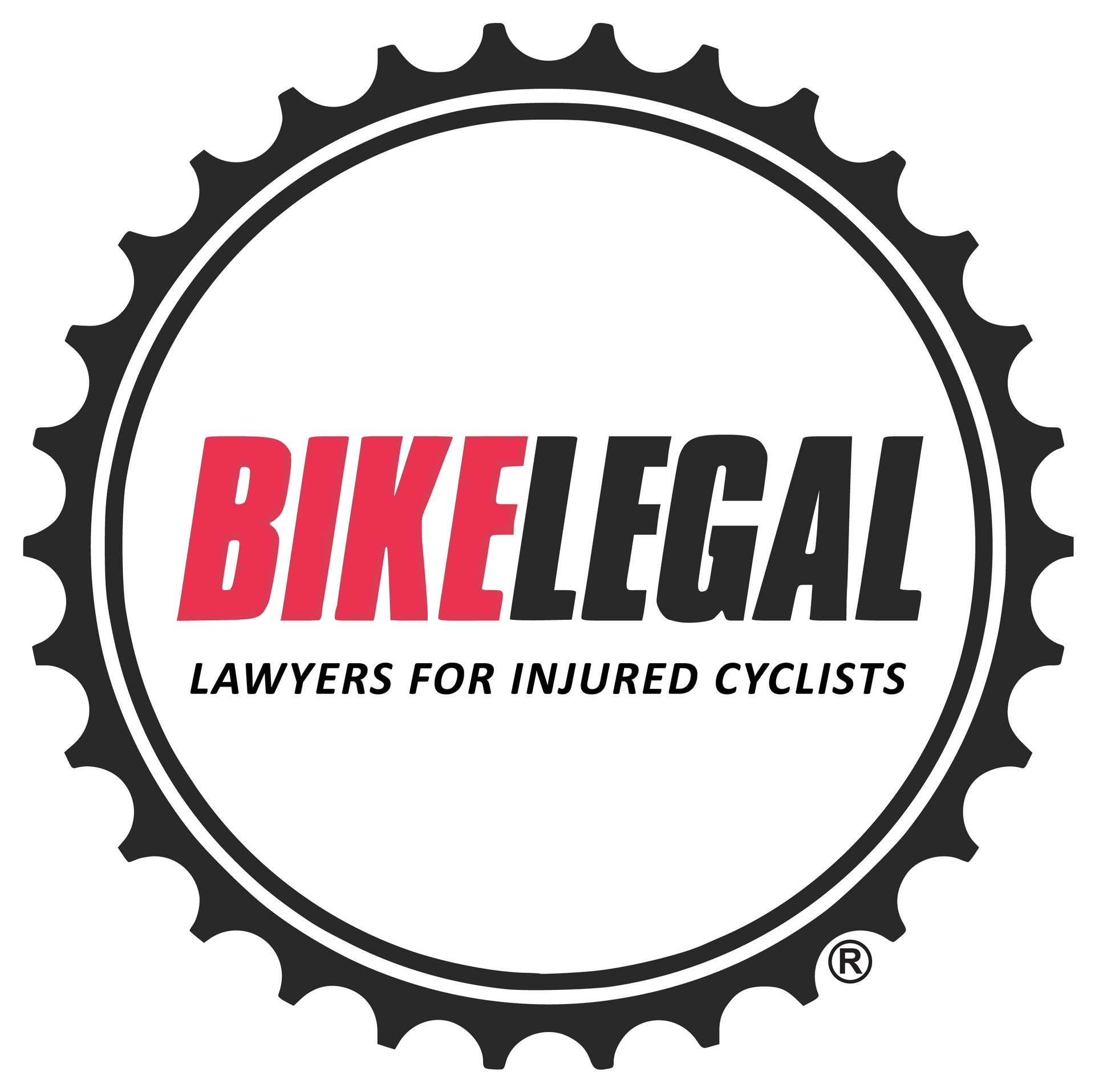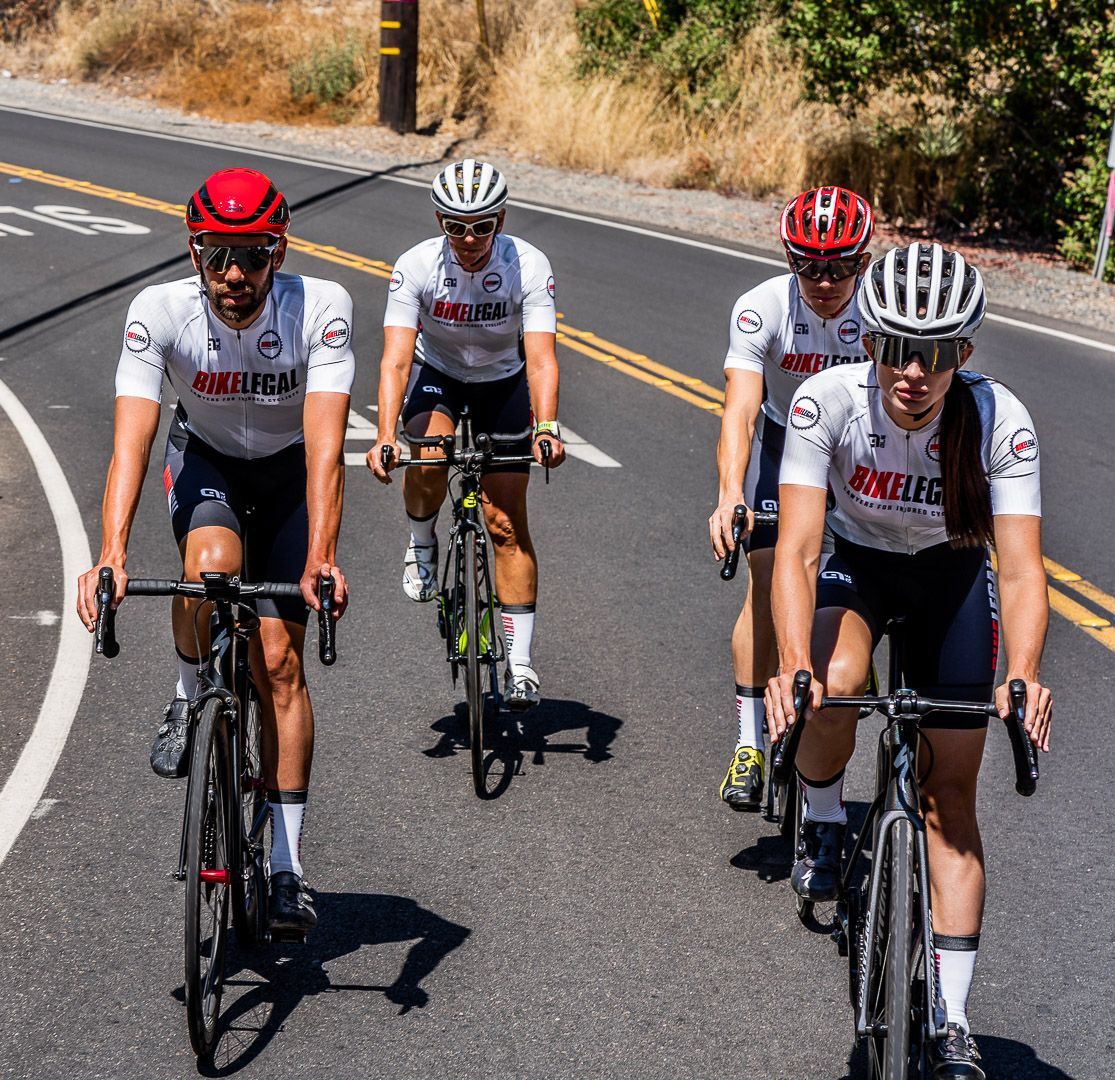What is a Professional Bike Fit, and is it Worth Your Money?
Follow us on
social media!
A professional bike fit is one of the most valuable investments a cyclist can make to enhance comfort, improve performance, and prevent injuries. Whether you're a casual rider or a competitive athlete, having a bike perfectly aligned with your body can make a world of difference. Misalignments between your body and your bike can lead to discomfort, inefficiency, and long-term injuries, diminishing your cycling experience.
In this guide, we’ll explore what a bicycle fit involves, the different types available, and the benefits of getting a professional fit. We'll also delve into whether the investment is worth it, when to get a fit, how to find a good bike fitter, and why it’s essential to reassess your fit regularly—especially after significant body changes like injury or pregnancy. Whether you're new to cycling or seeking to improve your performance, a proper bike fit can transform your riding experience.
Key Topics Include:
- What exactly is a bike fit?
- The difference between bike fitting and bike sizing
- Types of bike fits available
- Costs associated with bike fitting
- Benefits of a bike fit
- Who should consider a bike fit
- Can you do a DIY bike fit at home?
- When should you get a bike fit?
- How to find and select a good bike fitter
- What to bring to your bike fit session
- The bike fit process and key measurements
- Cycling shoes and insoles as part of the fit process
- How often should you get re-fitted?
What is a Bike Fit?
A bike fit is the process of adjusting a bicycle to align perfectly with the rider’s body, optimizing comfort, performance, and injury prevention. By fine-tuning key contact points—such as saddle height, cleat alignment, handlebar width, and position—a bike fit ensures that the bike is tailored to the rider’s unique body mechanics, flexibility, and riding style. This customization is essential for enhancing efficiency and reducing the strain on muscles and joints during rides.
What is the Difference Between Bike Fitting and Bike Sizing?
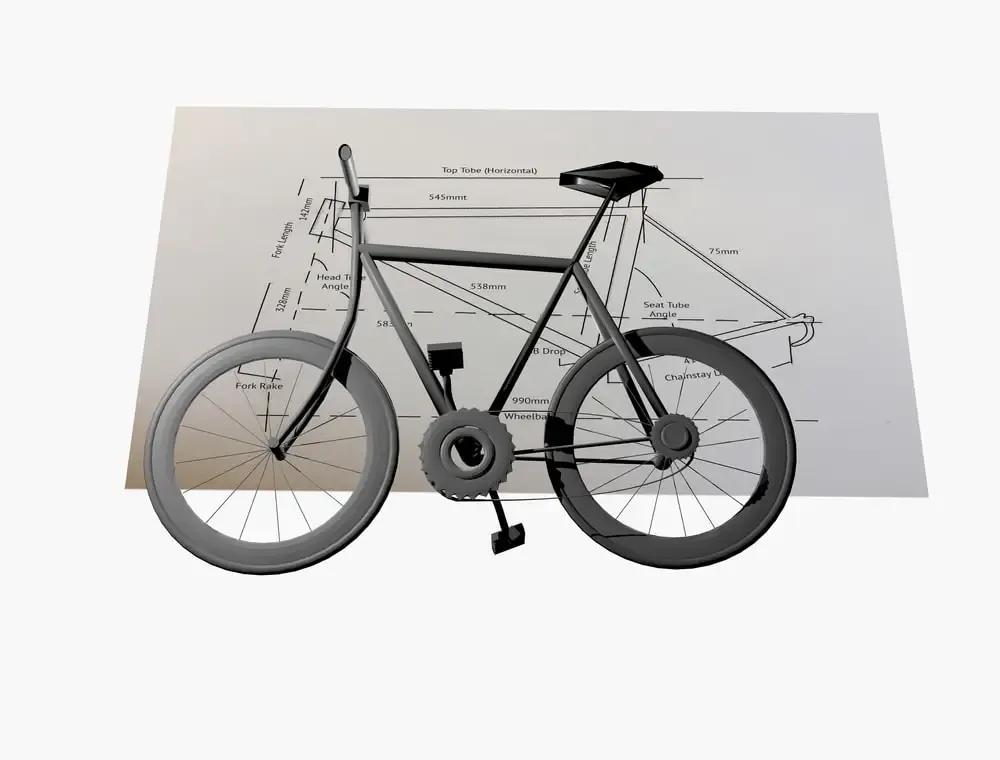
Bike sizing and bike fitting are two different processes that work together to ensure that your cycling experience is both comfortable and efficient. While they are related, they serve distinct purposes in matching a bike to your body and riding style.
| Aspect |
Bike Sizing |
Bike Fitting |
|---|---|---|
| Definition |
Determines the correct frame size based on body dimensions (height, inseam). | Adjusts specific contact points (saddle, handlebars, pedals) for optimal fit. |
| Focus |
Focuses on seat tube length, top tube length, and overall geometry. | Focuses on individual components’ adjustments for comfort and performance. |
| Purpose |
Ensures the bike’s geometry matches your body proportions. | Fine-tunes the bike for comfort, efficiency, and performance based on body mechanics, flexibility, and riding goals. |
| Key measurements |
Height, inseam length, seat tube length, top tube length. | Saddle rails and height, handlebars, pedals. |
| Goal |
To ensure the correct frame size for your body. | To create a personalized fit by adjusting contact points. |
Key differences
- Bike Sizing: Determines the correct frame size based on your height and inseam, ensuring the bike’s overall geometry is suitable for you.
- Bike Fitting: Adjusts the specific components (saddle rails and height, handlebars, pedals) to fine-tune the bike for comfort, efficiency, and performance.
What Are the Different Types of Bike Fits Available?
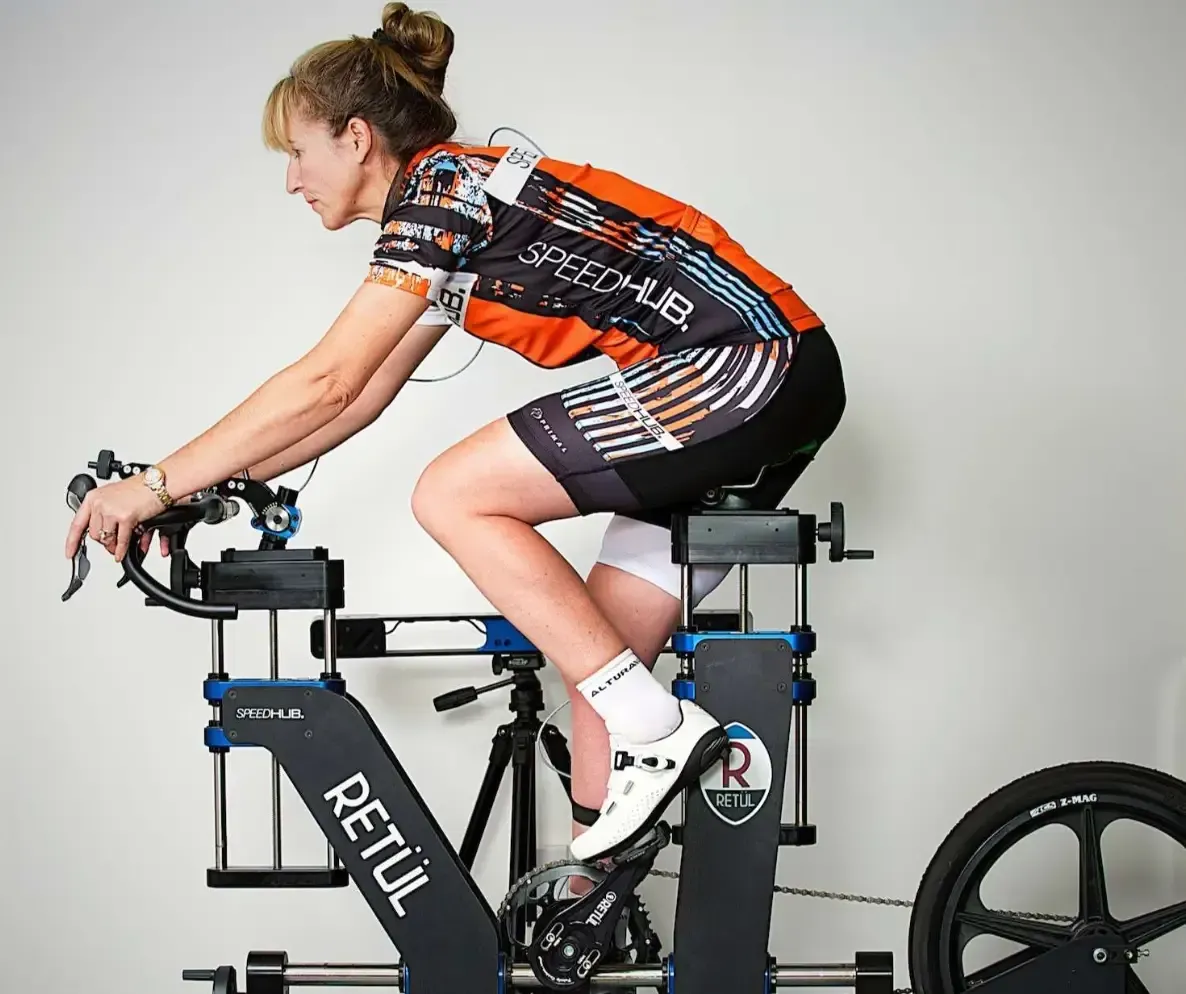
There are several types of bike fits available, each designed to address different needs, goals, and levels of cycling experience. Here are the main types:
1. Bike sizing
- Description: Bike Sizing is designed to help riders choose the correct frame size and geometry before buying a new bike. The fitter will measure your body and provide recommendations for frame sizes and bike models that will best suit you.
- Ideal For: Riders looking to invest in a new bike and want to know the best frame size.
- Pros: Ensures that you get a bike frame that suits your body’s proportions.
- Cons: Typically only identifies the proper frame size of the bikes that are sold at that particular bike shop.
2. Pre-purchase bike fit
- Description: A pre-purchase bike fit is a step beyond traditional bike sizing. In a fit studio, the cyclist rides a stationary fit bike while the fitter analyzes their posture and adjusts various elements—such as saddle height and handlebar reach—to find the most balanced, efficient and comfortable position for the rider. Once the ideal riding position is identified, the fitter takes measurements to determine which bike frame size and geometry will best suit the rider's body and riding goals.
- Ideal For: Any avid cyclist who wants to identify the best bike options and correct size for their individual needs.
- Pros: It takes the guesswork out of selecting the right bike and frame size. A fitter not affiliated with a specific bike shop can recommend any brand of bike that is best suited for the rider.
- Cons: Costs more than basic bike sizing.

Pro Tip from Nate Koch at Long Beach Bike Fit
Any avid cyclist should invest in a Pre-Fit. Bikes are expensive, so why risk spending $$$ on the wrong bike? A proper pre-fit should be done on a fit bike to understand the rider's correct position. Once the position is found, the fitter will use the fit bike measurements to identify the proper stack and reach of the frame, crank length, stem length, and handlebar reach. This helps significantly with recommending the perfect bike.
3. Basic bike fit (with bike shop bike purchase)
- Description: A basic bike fit is often included when purchasing a new bike at a bike shop. It typically includes simple adjustments to your seat height, handlebar position, and sometimes the cleat alignment. The goal is to ensure you're reasonably comfortable and properly positioned on the bike.
- Ideal For: New or casual cyclists who are looking for a basic, introductory fit without advanced technology
- Pros: It’s usually free or included with a bike purchase, and it provides a good starting point for beginners.
- Cons: This fit may lack the personalized attention needed for optimal comfort or performance, particularly for more experienced riders.
4. Professional comprehensive bike fit
- Description: A comprehensive bike fit that involves a detailed assessment of the rider's body, riding habits, and goals. The fitter uses a combination of body measurements, motion analysis, and real-time feedback to adjust the bike for optimal comfort, efficiency, and performance. This can involve adjustments to the saddle, handlebars, pedals, and cleats.
- Ideal For: Cyclists who are in the saddle frequently—whether road, mountain, gravel, or triathlon riders—who want to prevent injury, optimize performance, and improve overall comfort.
- Pros: Highly personalized, uses advanced tools such as video motion capture, and is based on rider-specific goals (e.g., comfort, endurance, speed).
- Cons: It can be more expensive (typically ranging from $150 to $300 or more), but the investment is worth the money.
5. Advanced or Performance Bike Fit
- Description: This type of fit is typically used by more serious, competitive cyclists or athletes looking to maximize every aspect of their performance. It involves high-tech tools such as 3D motion capture systems, pressure mapping, and dynamic bike fitting systems like Retül or Guru. These systems measure the rider’s biomechanics in real-time to fine-tune every element of the bike fit.
- Ideal For: Intermediate to advanced cyclists, triathletes, or those with specific performance goals who want to gain marginal improvements in speed, power, or aerodynamics.
- Pros: Provides the highest level of precision and performance benefits, and may include recommendations for custom equipment like saddles or insoles.
- Cons: Typically the most expensive option, ranging from $300 to $500, depending on the technology and depth of the fit.

Pro Tip from Nate Koch at Long Beach Bike Fit
For cyclists of all levels—whether you're new to the sport or a seasoned rider—an Advanced or Performance Bike Fit is the best option to get it done right the first time. This comprehensive service uses high-tech tools like 3D motion capture and pressure mapping to ensure every aspect of your fit is fine-tuned for maximum comfort and performance. In addition to the precise adjustments, this fit should include ongoing support with follow-ups and open communication via email, phone, or text. The goal is to ensure that your fit evolves with you, so you're always riding at your best.
6. Virtual or online bike fit
- Description: With the growing popularity of remote services, some bike fitting companies offer virtual bike fits where riders take their own measurements and submit videos or data to a fitter, who then provides recommendations for adjustments.
- Ideal For: Riders unable to visit a pro bike fitter in person or those looking for a cost-effective fit from the comfort of their home.
- Pros: Convenient and often less expensive than an in-person professional fit.
- Cons: Lacks the hands-on attention and detailed adjustments that come with an in-person fit.
Each type of bike fit serves different riders based on their goals, experience level, and riding frequency. Casual riders might benefit from a basic fit, while competitive cyclists should invest in a more advanced fit to optimize their performance.
How Much Does a Bike Fit Cost?
The cost of a bike fit can vary widely depending on several factors such as the level of detail involved, the experience of the fitter, and the location. Generally, you can expect to pay anywhere from $75 to $500 for a professional bike fit.
- Basic fit: A basic bike fit, which usually includes adjustments to saddle height, handlebar position, and cleat alignment, typically costs between $75 and $150.
- Professional comprehensive fit: A more detailed bike fit that includes an in-depth analysis of your riding style, body measurements, and possibly video analysis, ranges from $150 to $300.
- Advanced or performance bike fitting: Advanced fits offered by highly experienced fitters or specialized fitting centers, which might include dynamic analysis and high-tech tools like pressure mapping, can cost between $300 and $500 or more.
What Are the Benefits of a Professional Bike Fit?
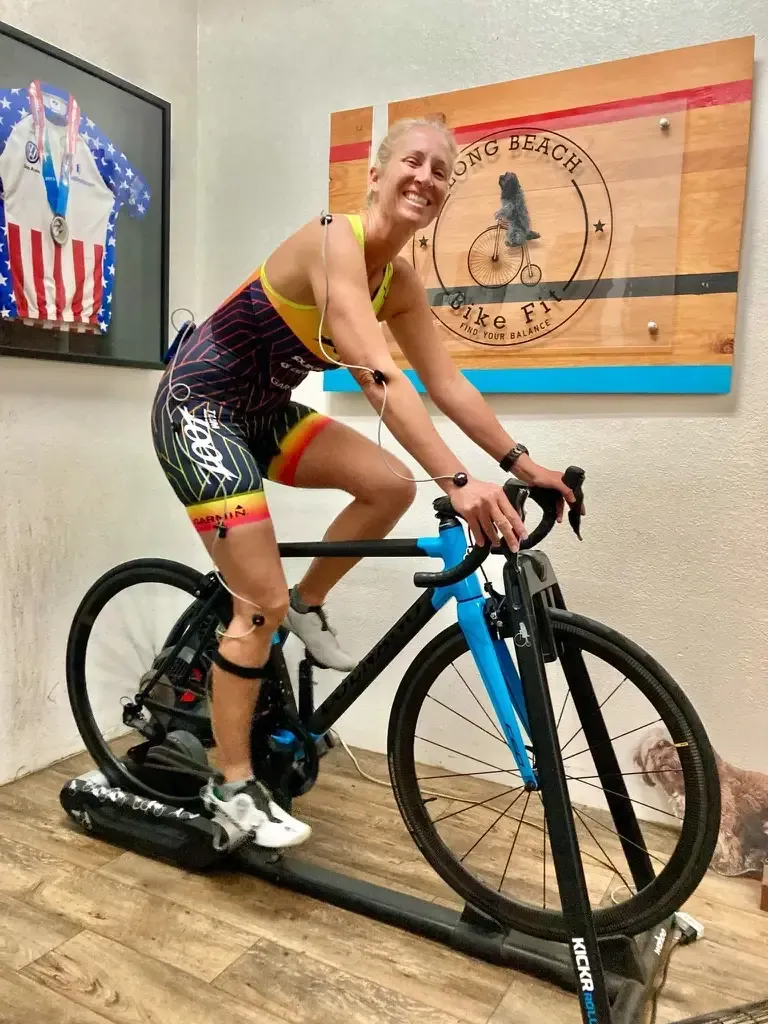
If you’re asking, "Do I need a bike fit?" consider whether you're experiencing pain or discomfort while riding, are recovering from an injury, or want to optimize cycling performance. A professional bike fit can make a significant difference for:
1. Enhanced comfort
One of the most immediate benefits of a professional bike fit is improved comfort. By adjusting the saddle, handlebars, and cleats to suit your body, a pro bike fitter helps you maintain a more natural and comfortable riding position.
This is particularly important for longer rides, where discomfort can lead to early fatigue or even injury. Proper adjustments to saddle height and angle, as well as handlebar reach and width, can prevent particular issues like back pain, saddle sores, hand and foot numbness, knee pain, or neck and shoulder pain.
2. Injury prevention
Poor bike fit can lead to overuse injuries, such as knee pain, back pain, and wrist or hand numbness. A professional bike fit ensures your body is properly aligned with your bike, reducing stress on joints and muscles.
By optimizing your position, a fitter can help prevent common cycling injuries like cyclist’s palsy (nerve compression in the hands), anterior knee pain, and lower back strain. For cyclists with a history of injuries, a professional fit is particularly important to avoid re-injury.
3. Saddle sore prevention
One common issue that arises from an improper bike fit is saddle sores—painful skin irritation or abrasions caused by prolonged pressure and friction between the saddle and your body. When your saddle height, angle, or fore/aft position isn’t properly aligned, you may experience increased pressure in sensitive areas, leading to discomfort and sores.
A professional bike fit can help distribute your weight evenly and ensure the saddle is positioned correctly, reducing the risk of saddle sores and improving overall comfort during long rides.
4. Improved pedaling efficiency
A professional fit not only optimizes the bike’s setup but also improves your overall pedaling technique, helping you generate more power with less effort. A good fit improves pedaling mechanics, allowing you to generate more power with less effort.
Adjusting your cleat position, saddle height, and crank length can optimize your leg extension and hip alignment, which improves the efficiency of each pedal stroke. This not only makes your rides easier but can also help you ride faster and with more endurance.
5. Increased power output
Many cyclists find that a professional bike fit leads to an increase in power output. By fine-tuning your position on the bike, a fitter can help you achieve better aerodynamics and optimal muscle engagement, resulting in more efficient power transfer to the pedals. This is especially beneficial for competitive cyclists, who can gain significant performance improvements from even small adjustments.
6. Reduced fatigue
When your bike is properly fitted, your body works more efficiently, which helps reduce fatigue on longer rides. Improper alignment can cause your muscles to work harder than necessary, leading to early exhaustion. A professional fit ensures that your energy is used effectively, allowing you to ride longer and with less strain on your body.
Who Should Consider Investing in a Professional Bike Fit?
A professional bike fit isn’t just for competitive cyclists—it benefits anyone who spends time on a bike. Even recreational cyclists benefit from a proper fit, as it ensures comfort and helps prevent common issues like back pain or numbness during casual rides.
Whether you ride for leisure, fitness, or competition, a proper fit can boost comfort, prevent injuries, and improve performance. If you're dealing with discomfort, recovering from an injury, or looking to ride more efficiently, a bike fit can help you get the most out of every ride.
Here’s a quick look at who should consider a bike fit:
1. Riders experiencing pain or discomfort
If you regularly experience pain while riding—whether it’s knee pain, back pain, saddle sores, or numbness in your hands—this is a strong indicator that your bike may not be properly fitted to your body. Even minor discomfort can build up over time, leading to long-term injuries. Professional bike fit services can address these issues by adjusting your position to reduce strain on problem areas.
2. Cyclists recovering from injury
Riders who have experienced an injury (whether cycling-related or otherwise) should consider a professional bike fit before getting back on the bike. A properly fitted bike can help prevent re-injury by aligning your body to reduce stress on sensitive areas. It can also accommodate physical changes resulting from injury, such as reduced flexibility or mobility.
3. Competitive or performance-oriented cyclists
Competitive cyclists, triathletes, and those looking to improve their performance can benefit significantly from a professional bike fit. Even small adjustments can lead to improved aerodynamics, better pedaling efficiency, and increased power output, all of which can make a difference in races or time trials. For performance-driven riders, optimizing body position can unlock significant gains in speed and endurance.
4. Frequent riders or long-distance cyclists
If you ride frequently or for long distances, even minor discomforts can become significant over time. A bike fit ensures that your body is positioned for comfort on long rides, helping to reduce fatigue and prevent overuse injuries. For those who ride multiple times a week or participate in events like centuries, a professional bike fit can make a huge difference in overall comfort and stamina.
5. New cyclists or those transitioning to a new bike
New cyclists often benefit from a professional bike fit to establish good riding habits and ensure they’re positioned correctly from the start. Additionally, if you're transitioning to a new bike or type of riding (such as moving from road cycling to triathlons or mountain biking), a bike fit can ensure your new setup aligns with your body and riding goals.
6. Riders experiencing changes in their body
As your body changes—whether due to weight loss, pregnancy, aging, age, or increased fitness level—your bike fit may need to be adjusted. A professional bike fitter can make sure your bike continues to fit your evolving body, helping you maintain comfort and performance over time.
Can I Do a Bike Fit Myself at Home?
You can attempt a DIY bike fit at home, especially if you’re looking to make simple adjustments like saddle height or handlebar position. However, DIY bike fitting has limitations—without the precision tools and experience of a professional fitter, you might not achieve optimal results, potentially missing underlying causes of discomfort.
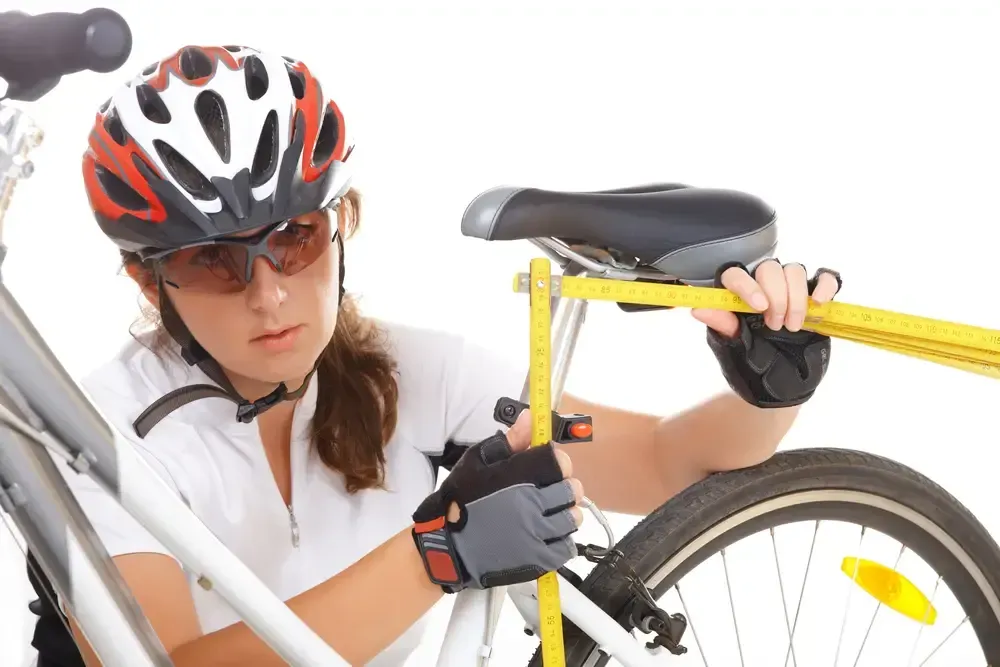
Steps for a basic DIY bike fit
- Adjust Saddle Height: One of the most critical elements, saddle height affects comfort and pedaling efficiency. A common method is the "heel-to-pedal" rule—when you place your heel on the pedal at its lowest point, your leg should be fully extended without over-stretching.
- Set Saddle Fore/Aft Position: While seated, place your foot on the pedal with the cranks horizontal (parallel to the ground). Your kneecap should be roughly in line with the pedal axle for proper positioning.
- Handlebar Height and Reach: The handlebar should be at a height that keeps you comfortable. If you're a casual rider, a higher handlebar might reduce strain on your back. More aggressive riders might prefer a lower handlebar for better aerodynamics.
- Cleat Positioning: For cyclists using clipless pedals, ensuring that your cleats are properly aligned with the balls of your feet can prevent knee pain and enhance power transfer. You can use guides or templates available online to align them correctly.
The limitations of a DIY bike fit
While a home bike fit can help with general comfort and alignment, it may not account for more complex adjustments that prevent long-term injuries or improve performance. DIY methods also lack tools like motion capture or pressure mapping, which professional fitters use to get precise measurements. For riders dealing with chronic pain, recovering from an injury, or looking to maximize performance, a professional bike fit is usually the best option.
When Should I Get a Bike Fit?
A bike fit is crucial at several stages in your cycling journey, whether you're a casual rider or a seasoned competitor.
Understanding when to get a bike fit can help prevent discomfort, avoid injuries, and maximize your riding potential.
- Before purchasing a new bike: Getting a pre-purchase bike fit is essential to ensure you select the correct frame size and geometry for your body. Without a proper fit, you may end up with a bike that doesn’t suit your proportions, leading to discomfort and the need for costly adjustments.
- After purchasing a new bike: If you’ve recently bought a bike without having a fit beforehand, it's essential to get a professional fit as soon as possible. This ensures that the bike is adjusted to your body and riding style. Even small misalignments can lead to discomfort, inefficient pedaling, and injuries.
- When experiencing pain or discomfort: If you’re dealing with consistent issues like knee pain, back discomfort, saddle sores, or things going numb, a bike fit can help diagnose and fix the problem. Discomfort often indicates that something in your setup—such as saddle height or cleat alignment is off.
- After a break from cycling or an injury: If you’ve taken time off from riding due to an injury or other factors, your body might have changed in ways that affect your fit. A re-fit can help you ease back into riding without exacerbating old injuries.
- When your fitness or riding goals change: As your fitness level improves or you shift to more aggressive riding (like racing or long-distance events), you may need to adjust your bike fit to match your new goals and increase flexibility.
- Every few years for regular maintenance: Just like any other equipment, your bike fit should be re-evaluated periodically. Your body may change over time, especially with age or weight loss, and regular check-ups ensure your bike continues to fit your evolving needs.
How to Find and Select a Good Bike Fitter
Choosing the right bike fitter is key to getting the most out of your bike fitting experience. Here are some essential factors to consider when searching for and selecting a bike fitter:
1. Look for experience in your type of cycling
Many bike fitters often have specific areas of expertise. For example, some may specialize in road cycling, while others focus on mountain bikes, gravel bikes, or triathlon setups. Make sure the fitter you choose has experience with the type of riding you do. If you’re a competitive cyclist, look for someone who has experience fitting athletes for racing and endurance events.
2. Check for credentials and certifications
While there is no singular certification for bike fitters, reputable fitters often have credentials from well-known bike fitting organizations. Some of the top certifications include:
- Retül: Known for its high-tech motion capture fitting system.
- International Bike Fitting Institute (IBFI): Offers multiple levels of bike fit certification.
- Trek Precision Fit: Used by many shops around the world.
- Serotta International Cycling Institute (SICI): Provides extensive training in bike fitting.
These credentials show that the fitter has undergone formal training and stays current with the latest bike fitting techniques.
3. Ask for recommendations and reviews
Word of mouth is one of the best ways to find a good bike fitter. Ask fellow cyclists, especially those who have had a successful fit, for recommendations. If you don’t have personal connections in the cycling community, check online reviews or visit cycling forums where riders share their bike-fitting experiences.

Pro Tip from Nate Koch at Long Beach Bike Fit
When searching for a good bike fitter, Yelp and Google Reviews are valuable resources. They provide insight into others' experiences and help you understand what to expect from the fitting process. Checking reviews can give you a sense of the fitter’s expertise, professionalism, and the quality of the overall experience.
4. Evaluate their fitting process and technology
Different fitters use different methods and tools to perform a fit. Some rely on traditional techniques, while others use advanced technology like 3D motion capture, adjustable stationary bikes, and pressure mapping systems. If you have specific needs or want a more precise fit, look for a fitter who uses tools like the Retül or Guru systems, which track body movement and optimize every element of the fit.
However, even fitters who don’t use high-tech systems can be very skilled. Sometimes, an experienced fitter with a sharp eye can provide a fit as good as, or better than, a technology-driven one. The key is the fitter’s ability to understand your body and riding.

Pro Tip from Nate Koch at Long Beach Bike Fit
The technology used during a bike fit is only as effective as the fitter’s ability to interpret the data. Just because a fitter uses advanced systems like Retül or Guru doesn’t guarantee the best results. A great fitter should be able to explain what the numbers mean and how they translate into bike adjustments. Look for a fitter who not only understands the technology but also has the experience and knowledge to apply it in a way that optimizes your bike’s fit for your specific needs.
5. Ask about their process
A good fitter will take the time to understand your cycling goals, riding history, and any discomforts or injuries you may have. They should ask you about your current setup, how often you ride, the terrain you ride on, and your long-term cycling goals. The more information they gather, the better they can tailor the fit to your specific needs.
If the fitter offers a follow-up session, that’s a good sign—they’re committed to ensuring the fit works for you after you’ve had some time to ride with the new adjustments.
What Should I Bring to My Bike Fit?
To get the most out of your professional bike fit, it’s important to come prepared with the right equipment and information.
Bringing the following items will help your fitter tailor your bike setup to your specific needs and riding style.
- Your bike: If you’re getting a fit for your current bike, bring it with you, as the fitter will be adjusting your current setup. If you're being fit for a new bike, this may not be necessary, but check with the shop or fitter beforehand.
- Cycling clothes: Wear your regular riding gear, including padded cycling shorts. Wearing your usual gear helps the fitter see how you naturally ride, ensuring a fit that reflects your typical posture and riding position. If you wear different clothing for different types of rides (e.g., long-distance vs. short commutes), mention this to the fitter.
- Cycling shoes and pedals: Bring the shoes and pedals you typically use. For cyclists with clipless pedals, cleat alignment is a crucial part of the bike fit. If you use multiple pairs of shoes or different types of pedals, let the fitter know, as these variations may affect your fit.
- Any relevant bike gear: If you use custom insoles, orthotics, or specific saddles, bring them along. These items can significantly affect your fit and need to be factored into the adjustments. Additionally, if you’re considering new gear—such as a different saddle or handlebar grips—let your fitter know so they can integrate those into the fit.
- A list of pain points or discomfort: Be prepared to discuss any areas of discomfort you experience during rides, such as knee pain, saddle soreness, or hand numbness. The more specific you are, the better the fitter can target adjustments to alleviate these issues.
- A description of your riding habits: Think about your typical rides. How often do you ride? How far? On what type of terrain? Knowing whether you’re training for long-distance events, racing, or commuting helps the fitter design a setup that best supports your goals.
- Any previous bike fit information: If you’ve had a bike fit before, bring any data or reports from that session. This information can give your fitter insight into what worked or didn’t work in the past, helping them make more accurate adjustments
- Hydration and snacks (if needed): A professional bike fit can take 1-4 hours, depending on the level of detail involved. Bring water and a light snack to stay comfortable, especially if the session includes periods of pedaling on a stationary bike
What to Expect During a Professional Bike Fit: The Process and Key Measurements
During the bike fit assessment, the fitter will take key measurements, including saddle height, handlebar reach, and cleat alignment. These key bike fitting measurements ensure your bike is fine-tuned for maximum efficiency and comfort.
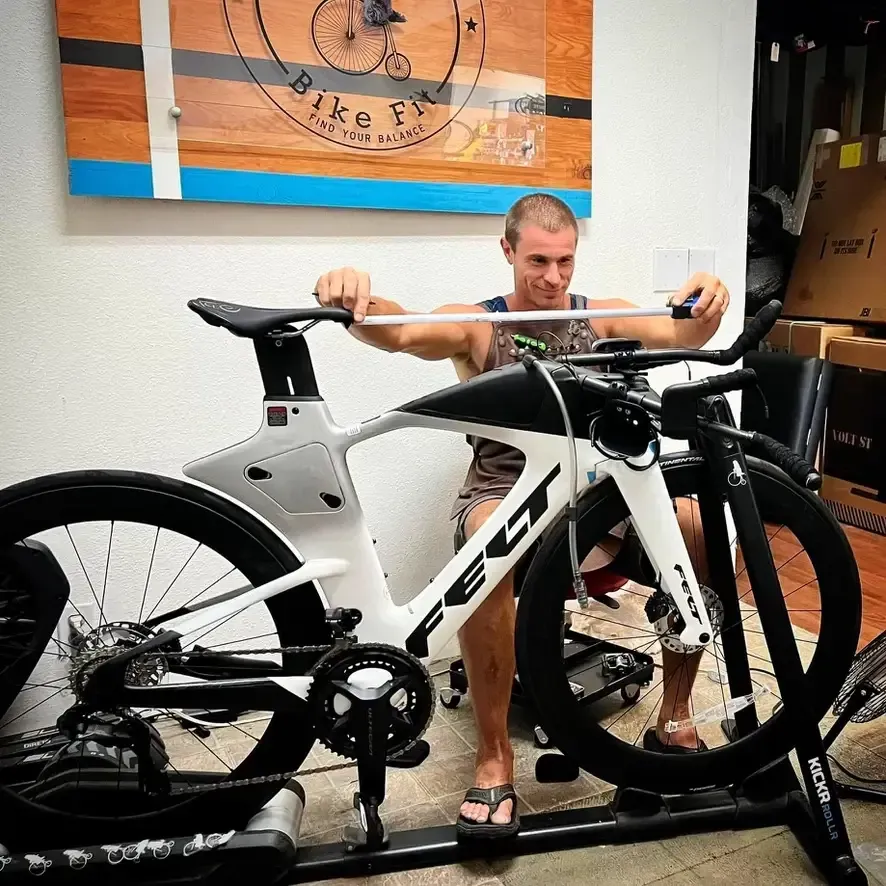
1. Initial consultation and interview
Most bike fitters start by with a conversation about your cycling background, riding habits, and goals. The fitter will ask questions such as:
- How often do you ride, and on what type of terrain?
- What are your performance goals (comfort, endurance, speed)?
- Are there any areas of discomfort or pain you experience during rides?
- Do you have any history of injuries or surgeries?
This information helps the fitter tailor the adjustments to your specific needs.
2. Off-bike assessment
The fitter will then assess your body’s structure, flexibility, and mobility. Key aspects of this assessment include:
- Leg length: To check for any discrepancies that may require adjustment in saddle height or cleat positioning.
- Foot stance and arch height: To understand how your feet naturally sit and ensure proper cleat alignment for balanced pedaling.
- Flexibility and range of motion: This helps the fitter determine the best handlebar position and whether you need a more aggressive or relaxed posture on the bike.
3. On-bike analysis
After the off-bike assessment, the fitter will have you ride your bike (or a stationary bike) to analyze your riding position and pedaling dynamics in real-time. Tools such as video capture, pressure mapping, or 3D motion analysis may be used to fine-tune your fit. Some key adjustments that might be made include:
4. Key measurements
Throughout the fitting, the fitter will take precise measurements of your body and bike. The most important measurements include:
- Saddle height: Ensures your legs are neither overextended nor cramped during the pedal stroke, which improves both comfort and efficiency.
- Saddle setback (Fore/Aft Position): your hips relative to the pedals for optimal power transfer and knee alignment.
- Handlebar reach: the distance between your saddle and handlebars to prevent excessive stretching or compression in your torso and shoulders.
- Handlebar drop: Fine-tunes the vertical distance between the saddle and handlebars to match your flexibility and riding style.
- Cleat alignment: Positions your feet correctly over the pedals, ensuring proper knee tracking and balanced power output.
5. Test riding and adjustments
Once the initial adjustments have been made, you’ll spend some time riding in your new position. The fitter will observe your posture and pedaling, making small tweaks as needed. This phase is crucial for identifying any last-minute changes that could enhance comfort or performance.
6. Post-fit feedback and follow-up
After the session, the fitter may give you feedback on how to adjust to your new setup, including tips on how to ride with the updated fit. A good fitter will offer a follow-up session after a few weeks to ensure that everything feels right once you’ve had time to ride with the new adjustments.
7. Expect the process to take 1-4 hours
Depending on the complexity of the fit and the technology used, a professional bike fit can take anywhere from one to four hours. It’s a thorough process designed to fine-tune every aspect of your bike setup for long-term comfort and efficiency
The Importance of Selecting the Right Cycling Shoes, Size, and Insoles
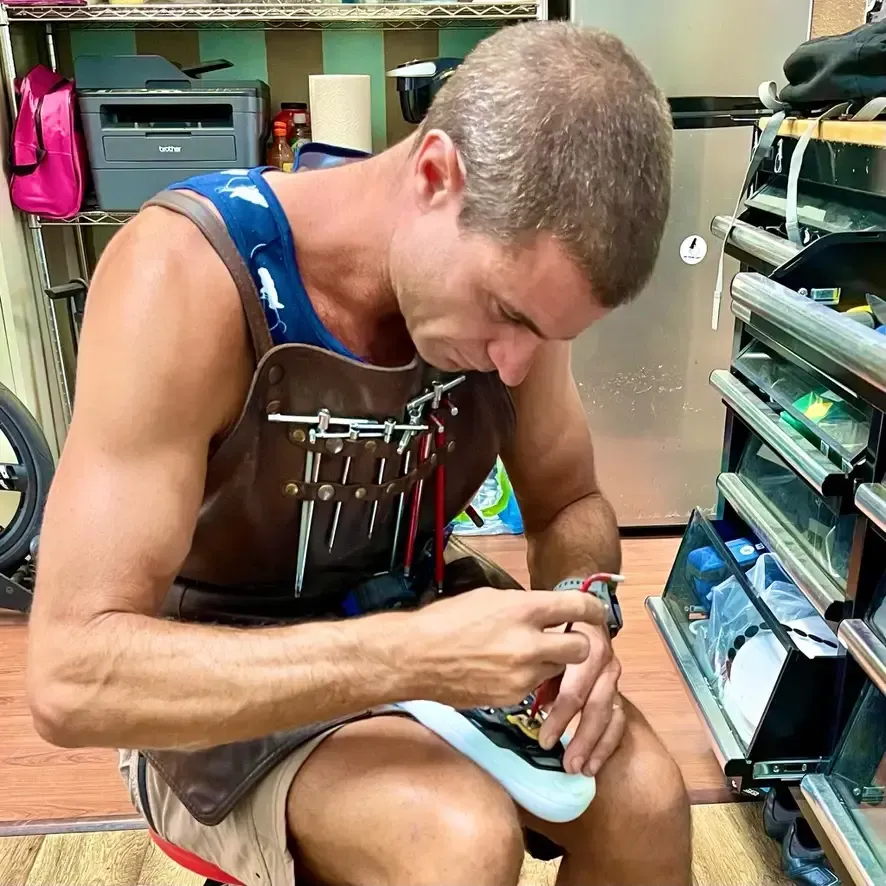
Choosing the right cycling shoes, size, and insoles is crucial for maximizing comfort and performance. Unlike regular shoes, cycling shoes are designed to be completely rigid, providing a stable platform that clips into the pedals and restricts movement.
This rigidity helps with efficient power transfer from your legs to the bike. However, selecting the right shoe size, width, and insole is essential for ensuring a proper fit and minimizing discomfort.
Key factors to consider:
- Proper shoe size and fit: Cycling shoes should fit snugly, but not too tight. The correct length and width are vital to avoid pinching or excess movement inside the shoe. A poor fit can lead to issues like foot numbness, hot spots, and discomfort over long rides.
- Cycling-specific insoles: The insoles that come with most cycling shoes are often basic and provide minimal support. Cycling-specific insoles offer more than just cushioning—they give your feet a firm platform, reducing fatigue and providing structural stability. This helps minimize arch fatigue, hotspots, and toe numbness, which are common issues with inadequate insoles.
- Foot stability: A well-fitted cycling insole ensures that your foot is balanced and stable inside the shoe, which reduces unnecessary movement that can lead to discomfort and even injury. Proper foot stability also allows the cleats to be positioned more accurately, ensuring efficient power transfer and preventing fatigue caused by misalignment.
How a Bike Fitter Can Help
A professional bike fitter can assist in selecting the right cycling shoes and insoles based on your foot structure, arch height, and riding style. They can also ensure your cleats are positioned correctly, reducing the risk of knee or hip issues and improving overall comfort and performance on the bike.
By working with a fitter, you can avoid common foot-related issues that many cyclists face, allowing you to ride more efficiently and comfortably.
How Frequently Should I Get a Bike Fit?
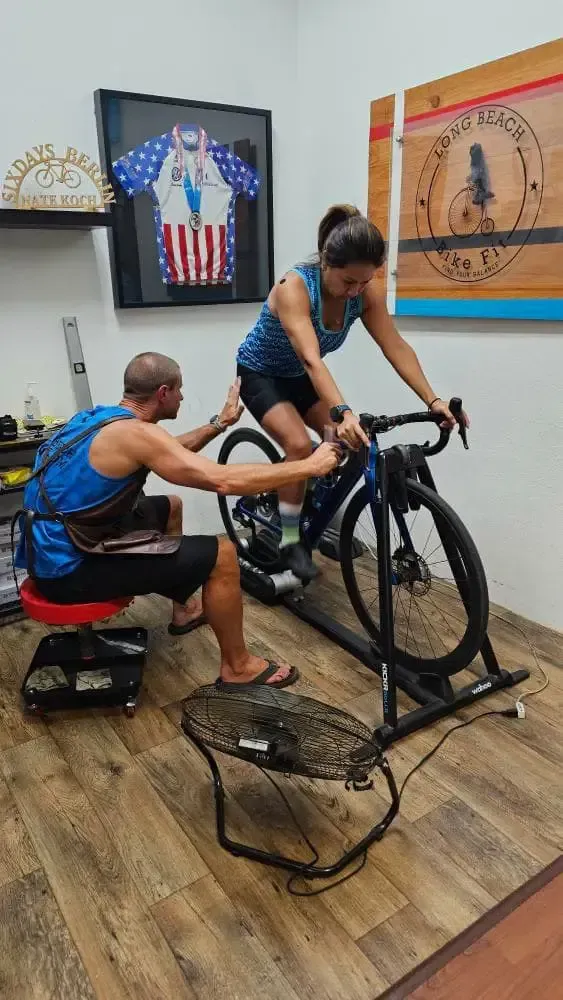
Reassessing your bike fit is essential to maintaining comfort, performance, and injury prevention, especially as your body and riding goals evolve.
Here’s when to consider getting a re-fit:
- When experiencing discomfort: When you are experiencing discomfort such as back pain, knee angle issues, saddle sores, or numbness, it's a strong indication that something in your setup—such as saddle height or cleat alignment—might be off. A re-fit can help diagnose and correct these issues, improving your comfort on the bike.
- After a break from cycling or an injury: If you've taken time off due to injury or other factors, your body may have changed in ways that affect your fit. A re-fit ensures that your bike is adjusted to accommodate these changes and helps prevent re-injury as you return to riding.
- When your fitness or riding goals change: As your fitness improves or you shift to more aggressive riding styles (such as racing or long-distance events), your bike fit may need to be adjusted to match these new goals. Increased flexibility or new performance goals often require re-tuning your bike fit for maximum efficiency.
- Regular maintenance every few years: Even without major physical changes, it’s recommended to get a re-fit every few years. As your body naturally changes with age, weight fluctuations, or improvements in strength and flexibility, regular check-ups help ensure that your bike continues to fit your body and riding style.
- After major body changes: Life events like pregnancy, significant weight loss, or aging can change your body’s posture, flexibility, and strength. A re-fit helps adapt your bike setup to these changes, ensuring long-term comfort and injury prevention.

Pro Tip from Nate Koch at Long Beach Bike Fit
The technology used during a bike fit is only as effective as the fitter’s ability to interpret the data. Just because a fitter uses advanced systems like Retül or Guru doesn’t guarantee the best results. A great fitter should be able to explain what the numbers mean and how they translate into bike adjustments. Look for a fitter who not only understands the technology but also has the experience and knowledge to apply it in a way that optimizes your bike’s fit for your specific needs.
The Bottom Line on Professional Bike Fits
A professional bike fit is worth the money for cyclists of all levels because it optimizes comfort, prevents injuries, and enhances cycling performance. The importance of bike fitting lies in ensuring that your bike is tailored to your body’s unique dimensions, improving pedaling efficiency, and reducing strain on joints.
With regular reassessments and attention to your body’s evolving needs, a bike fit becomes not just a one-time adjustment but an ongoing part of enjoying cycling to its fullest potential.
Don’t overlook the importance of a bike fit—it could be the key to unlocking better performance for years to come.
Ride Protected, Ride Safe, with BIKE LEGAL
A proper bike fit can enhance your cycling experience, but accidents can still happen. At Bike Legal, we’re cyclists advocating for cyclists, combining our passion for riding with legal expertise to protect your rights.
If you’ve been involved in a cycling accident, don’t face the aftermath alone. Let our dedicated team fight for the compensation you deserve while you focus on getting back in the saddle.
Get a Free Consultation Today
Contact Bike Legal to learn how we can support you on and off the bike. Together, we’ll ensure your rights—and your love for cycling—are safeguarded.
Request a free consultation by calling 877-BIKE LEGAL (877 245-3534)
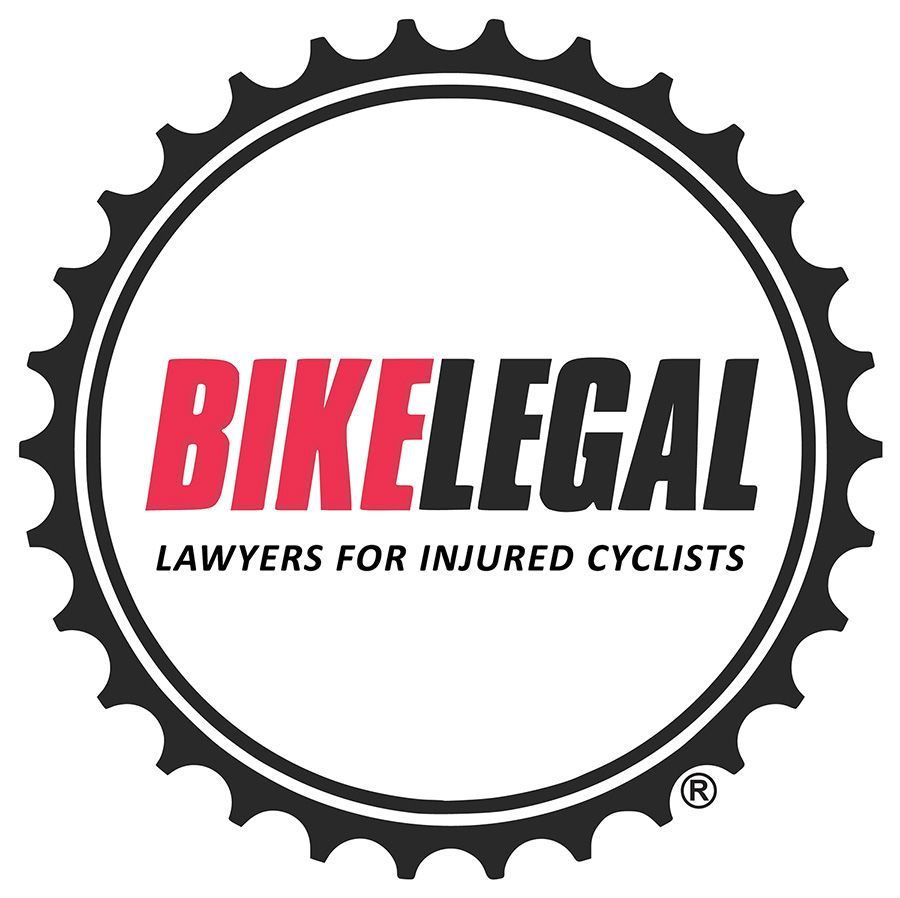
Frequently Asked Questions (FAQ's)
Is getting a bike fit worth it?
Yes, getting a bike fit is worth it for cyclists of all levels. It enhances comfort, prevents injuries, and improves performance by ensuring your bike is perfectly adjusted to your body. Whether you're a recreational cyclist or a serious rider, a professional bike fit optimizes your riding experience and helps you avoid discomfort or long-term strain.
What is the purpose of a bike fit?
The purpose of a bike fit is to align your bike with your body, optimizing comfort, performance, and injury prevention. By adjusting key elements like saddle height, handlebar position, and cleat alignment, a bike fit ensures efficient pedaling mechanics and reduces the strain on muscles and joints, regardless of your riding style or experience.
How long does a bike fit last?
A bike fit typically lasts anywhere from 1 to 4 hours, depending on the level of detail and technology involved. However, its effectiveness can last for years, though regular reassessments are recommended if your body changes due to injury, fitness improvements, or aging.
How to choose a bike fitter?
To choose a bike fitter, look for someone with experience in your specific type of cycling (e.g., road, mountain, or gravel). Check for certifications like Retül or IBFI, read reviews from other cyclists, and ask about their process and tools. A good bike fitter will take the time to understand your goals, riding history, and any discomfort to tailor the fit to your needs. Follow-up support is also a key factor to consider.
Read more articles from our educational blog:
